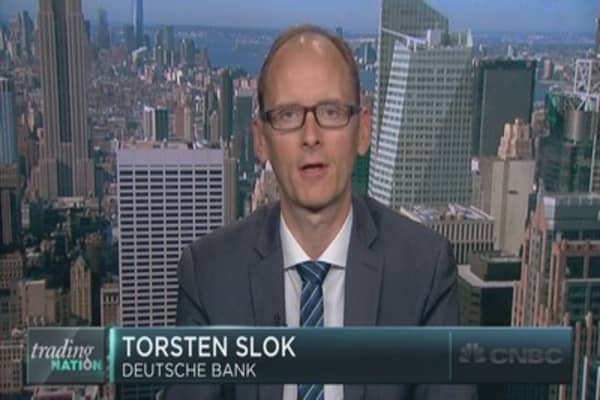
The slow growth the U.S. economy has experienced since the recent recession is not a fleeting condition, rather it’s the result with a serious demographic problem that is poised to dampen economic growth for years, according to a recent research paper by three Federal Reserve economists.
The economists’ model-based data analysis “suggests that demographic factors offer an explanation for puzzlingly weak business investment in the wake of the Great Recession, which some authors … have instead traced back to persistent uncertainty and limited investment decisions,” Etienne Gagnon, Benjamin Johannsen and David Lopez-Salido write in a working paper dated Oct. 3.
Even more troubling, their findings “further suggest that real GDP growth and real interest rates will remain low in the coming decades, consistent with the U.S. economy having reached a ‘new normal,'” a troubling theory that has also been referred to by the recently re-popularized term “secular stagnation.”
The extent to which demographic or other more fundamental issues have been responsible for the exceedingly slow recovery has been, as the authors imply, a hotly debated topic in economics. On one side are those who saw the slow recovery as a result of recession-specific problems such as a battered banking sector and the crumble in home prices; on the other, those who believe that demographic and perhaps technological changes have created a substantial hurdle for the economy to surmount, from which the credit and housing bubble only distracted us.
Which one of these explanations is most correct is an interesting and important question to answer in its own right, but it also has massive policy implications. If demographic trends are driving down the equilibrium interest rate — or the rate at which the demand and supply for money would naturally meet — then perhaps the Fed’s policy rates have not been so low after all, even if they look low by historical standards.
In fact, a paper written by San Francisco economist Vasco Curdia last year argues that the natural interest rate has been so low, the Fed’s policies were contractionary rather than stimulative even with the federal funds rate at the zero lower bound.
While Curdia’s focus was on the level of the equilibrium interest rate, Gagnon and his colleagues attempt to determine why it has fallen.
To do so, they cleverly contrasted the modeled equilibrium interest rate that would have resulted from fertility, mortality and employment rates remaining at their 1960 values to the modeled equilibrium rate that results from the shift in these trends.
They found that “the entirety of the decline in the equilibrium real [or inflation-adjusted] interest rate that our model finds for the recent decades is a direct consequence of the demographic changes that happened from 1960 onward.”
More specifically, the economists determined that the decline in fertility rates and the shift in employment rates have each taken 0.5 percent off of the equilibrium real rate from 1980 to the present; the mild increase in life expectancy has shaved off an additional 0.25 percent.
Essentially the issue boils down to a huge swath of Americans (the baby boomers) retiring and staying retired for longer, leaving a smaller pool of workers. This means that an increasing amount of capital is sitting around looking for investment opportunities, while the group of workers who wants to use that capital is diminishing. Simple supply and demand tells us that in this situation, the cost of that capital — a synonym for interest rates — will fall.
The diminishing of the labor supply is also to blame for low GDP growth, the authors conclude. This is not an altogether surprising conclusion, given that the labor supply is taken to be one of the prime inputs to economic growth.
The bad news is that this situation doesn’t seem destined to improve any time soon. “Going forward, the model predicts that the capital-labor ratio will remain elevated … because the growth rate of the labor supply will also be low, so that both real interest rates and GDP growth will linger near their current low levels,” write Gagnon et al.
While all three economists are part of the Fed’s research team, it is important to note that the paper is not to be interpreted as the official position of the Federal Reserve. Furthermore, no direct policy implications are drawn. Still, the acceptance of their conclusions would necessarily affect the Fed’s policies in addition to its forecasts.
In fact, the paper ends by noting that “the persistence of a low equilibrium real interest rate means that the scope to use conventional monetary policy to stimulate the economy during typical cyclical downturns will be more limited than it has been” — which can be taken to mean that unconventional policy options, perhaps including negative interest rates, would be in order.
“This is a very important paper, because this is the first time that the Federal Reserve is really recognizing what we’re talking about in financial markets, namely that growth will be low for quite some time,” Deutsche Bank chief international economist Torsten Slok commented Friday on CNBC’s “Trading Nation.”
Assuming their conclusion is accurate, the implications for investors are mixed, Slok explains. “Lower growth means lower earnings, but the flipside of that is that low interest rates means that equity valuations should be doing well.”
Slok takes the bullish perspective that in this “tug of war,” stocks are set to perform well.
In a slow growth world, stocks could look expensive, but still remain a far better bargain then ultra-low-yielding bonds, the economist
source”cnbc”




